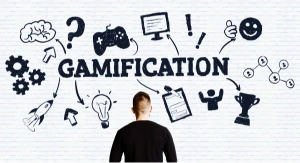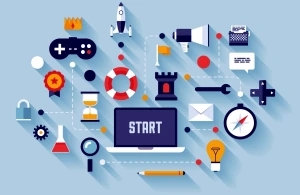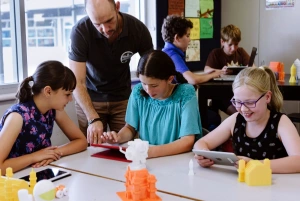Gamification of learning in VR has the potential to revolutionize education by creating engaging and effective learning experiences that prepare learners for the future. As VR technology continues to develop and become more affordable, we can expect to see even more innovative and exciting gamified learning experiences emerge.

Meaning Of Gamification Of Learning And Examples
Gamification of learning is all about incorporating game-like elements into traditional education to make it more engaging, interactive, and fun for students. It’s about tapping into the power of games to motivate learners, improve knowledge retention, and foster essential skills.
Here are some key ways gamification transforms learning:
Engaging Mechanics:
- Points, Badges, and Leaderboards: Earning points for completing activities, solving issues, or engaging in class fosters a sense of achievement and recognition. Leaderboards introduce a pleasant competitive element, pushing students to push themselves farther.
- Challenges and quests: Gamification transforms teachings from passive lectures to fascinating quests in which students solve puzzles, create virtual worlds, and collaborate to overcome hurdles. This active participation keeps kids engaged and driven.
- Immediate feedback and rewards: Real-time feedback on performance enables students to identify areas for growth and adapt their approach. Receiving rewards for attaining goals encourages positive behavior and motivates people.
Related: International Baccalaureate (IB) Program: A Global Education Perspective
Personalized Learning:
- Adaptive difficulty levels: Gamified learning can adjust to individual needs and learning styles, allowing students to progress at their own pace and choose difficulty levels that challenge them appropriately.
- Branched narratives and choices: Students can choose their path within the learning experience, making it more relevant and engaging. This caters to diverse learning styles and interests.
- Personalized challenges and rewards: Based on individual strengths and weaknesses, students can receive personalized challenges and rewards, promoting a more inclusive and effective learning process.
Related: International Students’ Mental Health Support
Benefits of Gamified Learning:
- Increased motivation and engagement: Making learning enjoyable and interactive increases the likelihood that students will be actively interested and motivated to achieve.
- Improved knowledge retention: Gamified experiences are more immersive and engaging than traditional techniques, which helps students recall information more effectively.
- Gamification can assist build critical thinking, problem-solving, cooperation, and communication skills by presenting exciting scenarios and challenges.
- Accessible and inclusive learning: Gamified experiences can enable equitable access to learning regardless of location or learning style, meeting a variety of needs.
Related: International Education Trends: Adapting To A Changing World

Examples of Gamified Learning Platforms:
- Duolingo: Learn languages through interactive lessons, earning points, and leveling up.
- Minecraft Education Edition: Build virtual worlds and collaborate on projects while learning about history, science, and technology.
- Kahoot: Create interactive quizzes and games to make learning fun and competitive.
- ClassDojo: Manage classrooms and motivate students with points, badges, and leaderboards.
- Memrise: Learn languages with games, flashcards, and social features.
Related: International Student Exchange Programs: Expanding Horizons Through Education
Challenges and Considerations:
- Cost and resources: Implementing gamified learning can require additional resources and technical expertise.
- Design and development: Creating effective gamified experiences requires careful design and development to ensure they are engaging and not overly complex.
- Potential for distraction: Gamification elements can be distracting if not designed carefully.
Related: Student Housing Options: Finding Your Home Abroad
Future Trends:
- VR and AR: Integrating virtual and augmented reality into gamified learning can create immersive and interactive experiences.
- AI-powered learning: AI can personalize learning paths, provide adaptive feedback, and create engaging challenges based on individual student data.
- Learning analytics: Analyzing data from gamified experiences can reveal useful information about student progress and learning styles, allowing for continual improvement.
As technology and design methodologies advance, we may expect to see even more inventive and profound gamification applications in learning, influencing the future of education.
Related: Studying Abroad Packing List: Essentials For International Students

How To Create Gamification In Education
Creating effective gamification in education requires careful planning, design, and implementation. Here’s a step-by-step guide to help you get started:
- Define Your Learning Objectives:
- What do you want students to learn or achieve through this gamified experience?
- Align your game elements and mechanics with these specific learning goals.
- Choose Your Game Elements:
- Points: Reward specific actions or achievements.
Badges: Recognize mastery of skills or completion of milestones. - Leaderboards: Foster healthy competition and individual/group effort.
- Levels: Provide a sense of progression and increasing difficulty.
- Quests and challenges: Create engaging narratives and tasks tied to learning objectives.
- Virtual rewards and power-ups: Enhance motivation and engagement.
- Design the Mechanics:
- Rules: Make them clear, simple, and easy to understand.
- Difficulty levels: Offer options for diverse learning styles and abilities.
- Feedback: Provide immediate and actionable feedback on performance.
- Progression system: Ensure a clear path for students to advance and achieve goals.
- Consider Individual Needs:
- How can you personalize the experience based on learning styles, preferences, and abilities?
- Offer choices and adaptations to ensure inclusion and accessibility.
- Implement and Facilitate:
- Introduce the game clearly and explain its purpose and rules.
- Model expected behaviors and interactions within the game.
- Facilitate collaboration and competition as needed based on learning objectives.
- Address any technical challenges or unexpected issues promptly.
- Monitor and adapt.
- Monitor student progress and involvement in the game.
- Gather comments from students and teachers on the effectiveness of the event.
- Be prepared to change the rules, difficulty levels, or mechanics based on feedback and observations.
- Assess and evaluate:
- Go beyond points and badges to assess students’ conceptual knowledge, skill progress, and overall learning outcomes.
- Use game data to guide future teaching and gamification strategies.
Related: Online International Education: Exploring Virtual Learning
Additional Tips:
- Involve students in the design process: This can increase their buy-in and ownership of the experience.
- Focus on intrinsic motivation: Encourage students to see the value of learning beyond points and badges.
- Connect the game to real-world applications: Help students see how the skills and knowledge they gain can be used outside the classroom.
Have fun! Your enthusiasm and positive attitude can significantly impact the success of gamified learning.
Related: Global Citizenship Education: Fostering Inclusivity And Tolerance

The Types Of Gamification
When it comes to gamification, there isn’t a one-size-fits-all approach. Different types of gamification techniques suit various contexts and objectives. Here’s a breakdown of some common types:
Structural Gamification:
- Applies game elements (points, badges, leaderboards) to non-game contexts like learning or training.
- Focuses on boosting motivation and engagement through extrinsic rewards and competition.
- Examples: Duolingo’s points and badges, classroom management apps with points for good behavior.
- Pros: Simple to install, boosts participation, and adapts to different circumstances.
- Cons: Can be shallow, does not ensure deeper learning, and requires careful planning to avoid distraction.
Related: Study Abroad Reflection: International Students’ Experiences
Content Gamification:
- Incorporates game-like aspects right into the learning content.
- Focuses on developing immersive and interactive experiences that teach certain skills or knowledge.
- Examples: Minecraft Education Edition, medical simulation games, and historical strategy games.
- Pros: Deeper engagement, promotes problem-solving and critical thinking, fosters active learning.
- Cons: Development can be expensive, requires dedicated time and resources, and may not be suitable for all learning objectives.
Related: Staying Connected Using Technology
Narrative Gamification:
- Uses storytelling and game mechanics to engage learners in an overarching narrative.
- Focuses on emotional engagement and motivation through a story-driven experience.
- Examples: Role-playing games with educational themes, and interactive fiction with learning objectives.
- Pros: Highly immersive, memorable experiences, promote empathy and decision-making skills.
- Cons: Can be complex to design, may not be suitable for all subjects, requires strong storytelling skills.
Related: Language Immersion: Mastering a New Tongue

Adaptive Gamification:
- Tailors the gamified experience to individual learners based on their progress, strengths, and weaknesses.
- Focuses on personalized learning and providing challenges that match individual needs.
- Examples: Learning platforms that adjust difficulty levels based on performance, and games that offer different learning paths.
- Pros: Maximizes individual learning potential, caters to diverse needs, and increases intrinsic motivation.
- Cons: Requires complex technology and algorithms, data privacy concerns, and potential for bias.
Related: Study Abroad Visa Interview: Navigating The Application Process
Other types:
- Assessment-based gamification: Uses game elements to make assessments more engaging and interactive.
- Community-based gamification: Leverages social interaction and competition to motivate learning within a community.
- Empathy-based gamification: Uses game mechanics to simulate real-world experiences and foster empathy.
Related: Study Abroad Scholarships: Funding Your Global Educational Adventure
Choosing the right type:
The best type of gamification depends on your specific learning objectives, resources, and target audience. Consider factors like:
- Learning goals: What knowledge, skills, or attitudes do you want learners to gain?
- Target audience: Who are you designing the gamified experience for? What are their needs and preferences?
- Resources: What budget, time, and expertise do you have available?
- Technology: What technological tools and platforms can you use effectively?
Related: Choosing The Perfect Destination: Where To Study Abroad

How To Engage Students In Gamification
Keeping students engaged in gamified learning experiences requires more than just throwing in points and badges. Here are some key strategies to ensure maximum engagement and a fruitful learning journey:
Before you begin:
- Understand your audience: Know your students’ interests, learning styles, and technology preferences. Tailor the gamified experience accordingly.
- Focus on intrinsic motivation: While rewards are fun, emphasize the value of learning the content itself. Highlight its real-world applications and connect it to students’ passions.
Related: Gap Year Adventures: Maximizing Learning Opportunities Abroad
During implementation:
- Start with a strong narrative: Craft an engaging story or theme that ties into the learning objectives. Use it to introduce challenges, quests, and rewards seamlessly.
- Offer choice and personalization: Allow students to choose avatars, customize their experience, and progress at their own pace. This caters to diverse learning styles and keeps them feeling in control.
- Incorporate variety: Use a mix of game elements like points, badges, leaderboards, challenges, and virtual rewards to keep things fresh and exciting.
- Provide immediate feedback: Let students know how they’re doing instantly. Offer constructive feedback and guide them to improve their performance.
- Foster collaboration and competition: Allow students to work together on challenges or compete individually or in teams, depending on the learning objectives.
- Integrate humor and playfulness: Don’t be afraid to have fun! Incorporate humor, lighthearted elements, and playful interactions to maintain a positive and engaging atmosphere.
- Celebrate success: Recognize and reward individual and group achievements. This motivates students to continue progressing and strive for more.
Related: Cultural Exchange: Embracing Diversity In Your Study Abroad

Additional Tips:
- Involve students in the design process: Let them contribute ideas, choose game elements, and even help create challenges. This increases their ownership and buy-in.
- Use technology effectively: Choose tools and platforms that are user-friendly, reliable, and aligned with your learning objectives. Avoid overly complex tech that might hinder the experience.
- Be transparent and fair: Clearly explain the rules, scoring system, and consequences for actions. Ensure everyone has an equal chance to succeed and progress.
- Continuously adapt and improve: Be open to feedback from students and adjust the game mechanics, challenges, or narrative based on their needs and preferences.
Related: STEM Study Abroad: Exploring Science And Technology Worldwide
Remember:
- Gamification is a tool, not a magic solution. Its effectiveness depends on careful planning, thoughtful design, and ongoing adaptation.
- The ultimate goal is to make learning fun, engaging, and meaningful. If you can achieve that, students will naturally be more motivated and invested in the gamified experience.
Related: Internship Abroad: Gaining Practical Experience While Studying

The Teacher’s Role In Gamification
In the fascinating realm of gamified learning, teachers play a critical part in its success. Here’s an overview of the important areas where instructors may make a difference:
Designing interesting experiences.
- Identify learning objectives: Identify what students should learn and ensure that game features are consistent with those objectives.
- Choose the proper game mechanics: Choose the appropriate points, badges, challenges, and prizes to inspire students and link to their learning objectives.
- Craft engaging narratives: Create a story or context that immerses students in the learning experience and makes it more meaningful.
- Balance challenge and reward: Design challenges that are achievable but still require effort, and provide meaningful rewards for achieving them.
Related: Scholarships For High School Seniors: Planning For Higher Education
Facilitating and managing the game:
- Set clear expectations and rules: Explain how the game works, how points are earned, and how behavior is expected within the gamified environment.
- Provide ongoing feedback and support: Offer guidance and encouragement to students as they navigate the game, addressing any difficulties they encounter.
- Encourage kids to collaborate, share expertise, and assist one another during the game.
- Track progress and adapt: Monitor student progress and alter game mechanics or difficulty level as necessary to guarantee a balanced and successful learning experience.
Related: Reverse Culture Shock After Study Abroad

Assessing and reflecting on learning:
- Utilize data from the game: Analyze performance data to identify areas of strength and weakness in individual students and the class as a whole.
- Go beyond points and badges: Look for evidence of deeper learning, such as critical thinking, problem-solving, and communication skills developed through the game.
- Reflect on your role: Evaluate your effectiveness in facilitating the gamified learning experience and identify areas for improvement.
Related: UNESCO’s Role In Shaping Global Education Policies
Additional factors to consider:
- Technology skills: Understanding applicable technology platforms and tools might be beneficial.
- Collaborate with other teachers, instructional designers, or game developers to get experience and support.
- Continuous learning entails keeping up with the newest trends and best practices in gamified learning.
These roles and duties can help teachers become great game masters, directing students on a fun and productive learning trip. The most crucial part is to foster a pleasant and inclusive learning atmosphere in which all students feel inspired and encouraged to reach their full potential.
Related: Teaching Abroad: Your Path To An International Educational Career

What Sets Gamification Apart From Game-Based Learning
While game aspects are used for learning in both gamification and game-based learning (GBL), their primary methods and points of emphasis are different:
The process of Gamification
- Adapts features and mechanics from games to non-gaming situations. This is giving tasks that are often performed outside of games—like exercising, making sales, or providing customer service—points, badges, leaderboards, challenges, and stories.
- Focuses on inspiring users to participate in a particular activity. The main objective is to raise achievement, effort, and participation in a particular setting.
- Examples include the language-learning app Duolingo, the fitness club Nike Run Club, and the classroom management app ClassDojo.
Related: International Student Insurance Options For Studying In The U.S
Game-based Learning (GBL):
- Makes use of full games as the main teaching resource. These games, which frequently include aspects of simulation, problem-solving, and storytelling, are made expressly to teach particular skills or knowledge.
- Focuses on using the gaming experience to impart particular knowledge or abilities. Playing the game results in the intended learning outcomes since the game is the learning environment in and of itself.
- Examples include Civilization VI for historical strategy, Surgeon Simulator for medical instruction, and Minecraft Education Edition for STEM education.
Related: Resources For Students With Disabilities: Special Education Admission

Additional Points:
- Gamification can be seen as a subset of GBL, as it uses game elements within a broader context.
- GBL can be more immersive and engaging than gamification, as the entire game experience is designed for learning.
- Both approaches can be effective for different learning goals and contexts.
- The choice between gamification and GBL depends on the specific learning objectives, target audience, and available resources.
Related: International Schools vs. Local Schools: A Parent’s Guide
Conclusion
With its ability to create effective and interesting learning experiences that equip students for the future, gamified learning in virtual reality holds the potential to completely transform education. We should anticipate seeing even more cutting-edge and fascinating gamified learning experiences appear as virtual reality technology advances and becomes more accessible.

